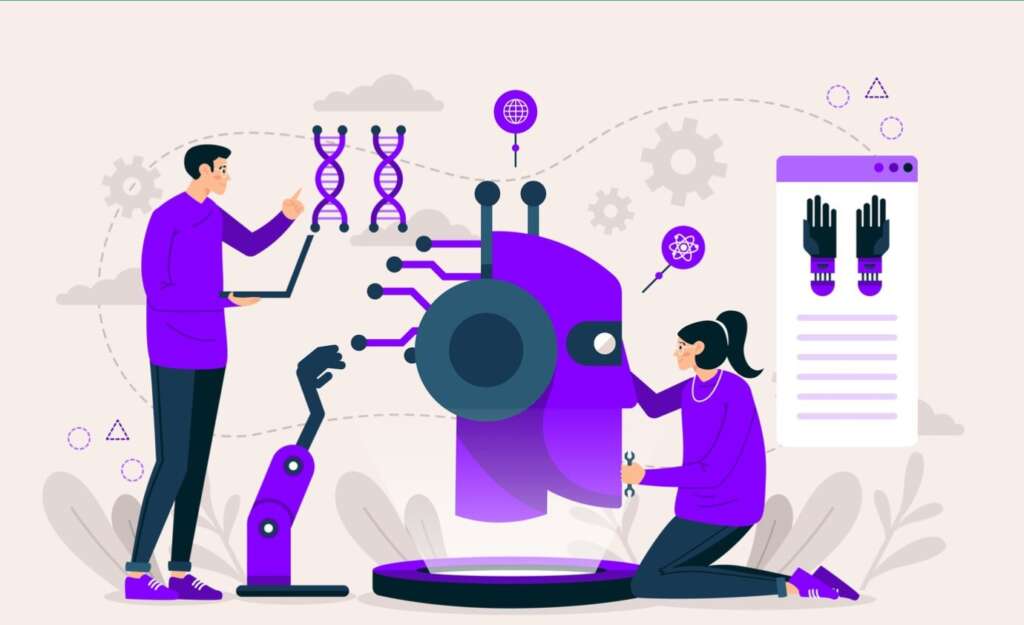Future of work and AI technology
The future of work is rapidly changing, thanks to advancements in artificial intelligence (AI) technology. As AI continues to evolve and become more integrated into various industries, it is crucial for businesses to adapt and prepare their workforce for this transformation. In this article, I will explore the importance of upskilling employees for AI technology and provide insights on how businesses can effectively retain and upskill their employees to thrive in the AI-driven era.
Importance of upskilling employees for AI technology
As AI technology becomes more prevalent, traditional job roles are being automated, leading to a shift in the skills required by employees. Upskilling employees for AI technology is essential for several reasons. Firstly, it ensures that businesses can leverage the full potential of AI to enhance productivity, efficiency, and innovation. By equipping employees with the necessary skills to work alongside AI, businesses can optimize their operations and stay competitive in the market.
Secondly, upskilling employees for AI technology helps to future-proof their careers. As AI continues to advance, it is expected to replace routine tasks and jobs that can be automated. By upskilling employees, businesses can empower their workforce to take on more complex and strategic roles that cannot be easily replaced by AI. This not only enhances job security for employees but also provides them with opportunities for personal and professional growth.
Lastly, upskilling employees for AI technology fosters a culture of continuous learning within the organization. By investing in the development of employees’ skills, businesses demonstrate their commitment to their workforce’s growth and development. This can boost employee morale, engagement, and loyalty, leading to higher retention rates and a more motivated workforce.
Benefits of upskilling employees for AI technology

Upskilling employees for AI technology brings numerous benefits to businesses. Firstly, it enables businesses to adapt to technological advancements and stay ahead of the curve. By providing employees with the skills needed to effectively work with AI, businesses can leverage technology to streamline processes, improve decision-making, and enhance overall performance.
Secondly, upskilling employees for AI technology fosters a culture of innovation. When employees are equipped with the necessary skills, they are more likely to explore new ways of utilizing AI technology to solve complex problems and drive innovation within the organization. This can lead to the development of new products, services, and processes that give a competitive edge to the business.
Additionally, upskilling employees for AI technology promotes collaboration and teamwork. When employees have a shared understanding of AI and its capabilities, they can collaborate more effectively with AI systems and tools. This synergy between human intelligence and AI technology can result in improved decision-making, problem-solving, and creativity.
Understanding the skills needed for AI technology
To effectively upskill employees for AI technology, it is essential to understand the skills required in this domain. While technical skills such as programming, data analysis, and machine learning are crucial, it is equally important to develop soft skills that complement AI technology.
Technical skills are necessary for employees to understand and work with AI systems. These skills include proficiency in programming languages such as Python, R, or Java, data analysis and visualization, and machine learning algorithms. It is important to provide employees with training and resources to develop these technical skills.
In addition to technical skills, soft skills play a vital role in working with AI technology. These skills include critical thinking, problem-solving, creativity, communication, and adaptability. Soft skills enable employees to effectively collaborate with AI systems, interpret and analyze data, and make informed decisions based on AI-generated insights.
When developing an upskilling program for AI technology, it is crucial to strike a balance between technical and soft skills. By providing comprehensive training in both areas, businesses can ensure that their employees are well-equipped to leverage AI technology effectively.
Assessing the current skillset of your employees
Before implementing an upskilling program for AI technology, it is important to assess the current skills of your employees. This assessment will help identify skill gaps and determine the specific training needs of each employee. There are several methods to assess the current skillset of employees, including:
Conducting skills assessments: This involves administering tests or assessments to evaluate employees’ technical and soft skills. Skills assessments can provide insights into employees’ strengths and weaknesses, allowing businesses to tailor the upskilling program accordingly.
Gathering feedback: Engaging in one-on-one conversations or surveys with employees can provide valuable insights into their self-perceived skills and areas they wish to develop. This feedback can help businesses identify common skill gaps and develop targeted training programs.
Reviewing performance evaluations: Performance evaluations can provide information on employees’ current job performance and areas for improvement. By analyzing performance evaluations, businesses can identify skill gaps that need to be addressed through upskilling.
By assessing the current skills of employees, businesses can develop a targeted upskilling program that addresses specific skill gaps and meets the unique needs of each employee.
Developing an upskilling program for AI technology
Once the skill gaps have been identified, businesses can begin developing an upskilling program for AI technology. The following steps can help in designing an effective upskilling program:
Set clear goals and objectives: Define the desired outcomes of the upskilling program. This could include specific technical skills to be acquired, improvements in problem-solving abilities, or increased collaboration with AI systems. Clear goals and objectives will guide the development and implementation of the program.
Choose the right training methods: Consider various training methods such as instructor-led training, online courses, workshops, or mentoring programs. Different employees may respond better to different training methods, so it is important to offer a variety of options to cater to individual learning preferences.
Provide hands-on experience: Practical application of skills is crucial for effective upskilling. Incorporate opportunities for employees to work on real-world projects or simulations that allow them to apply their newly acquired skills in a practical setting. This hands-on experience will enhance their confidence and proficiency in working with AI technology.
Offer continuous learning opportunities: Upskilling is an ongoing process. Provide employees with access to resources, webinars, workshops, or conferences that allow them to stay updated on the latest advancements in AI technology. Encourage employees to engage in continuous learning to stay ahead in the rapidly evolving AI landscape.
By following these steps, businesses can develop a comprehensive upskilling program that equips employees with the necessary skills to work effectively with AI technology.
Implementing the upskilling program
Implementing the upskilling program requires careful planning and execution. The following strategies can help ensure successful implementation:
Gain leadership buy-in: Secure support from top-level executives and managers to ensure the upskilling program receives the necessary resources, funding, and organizational support. Leadership buy-in is crucial for creating a culture that values upskilling and encourages employees to participate in the program.
Communicate the benefits: Clearly communicate the benefits of the upskilling program to employees. Highlight how acquiring new skills will enhance their job security, career prospects, and personal growth. Emphasize the value of upskilling in adapting to the changing nature of work and the opportunities it presents.
Foster a learning culture: Create an environment that promotes continuous learning and upskilling. Encourage employees to share knowledge, collaborate, and support each other in their upskilling journey. Recognize and reward employees who actively participate in the program and demonstrate their newly acquired skills.
Provide dedicated resources: Allocate resources such as time, budget, and access to training materials or platforms to support employees’ upskilling efforts. Ensure that employees have the necessary tools and technologies to acquire and apply their new skills effectively.
By implementing these strategies, businesses can create an environment that supports and encourages employees to actively participate in the upskilling program.
Providing ongoing support and resources for upskilling
To ensure the success of the upskilling program, it is crucial to provide ongoing support and resources to employees. The following measures can help in this regard:
Assign mentors or coaches: Pair employees with experienced mentors or coaches who can provide guidance, support, and personalized feedback throughout the upskilling journey. Mentors can help employees navigate challenges, set goals, and track progress.
Create a knowledge-sharing platform: Establish a platform or online community where employees can share insights, resources, and best practices related to AI technology and upskilling. This platform can foster collaboration, peer learning, and continuous improvement.
Offer continuous feedback and evaluation: Regularly assess employees’ progress and provide constructive feedback on their upskilling efforts. This feedback can help employees identify areas for improvement and adjust their learning strategies accordingly.
Facilitate networking opportunities: Organize networking events, conferences, or workshops where employees can interact with industry experts, thought leaders, and peers. These networking opportunities can provide inspiration, exposure to new ideas, and facilitate the exchange of knowledge and experiences.
By providing ongoing support and resources, businesses can create a supportive learning environment that enables employees to thrive in their upskilling journey.
Measuring the impact of upskilling on employee retention and productivity
Measuring the impact of upskilling on employee retention and productivity is essential to evaluate the effectiveness of the upskilling program. The following metrics can be used to assess the impact:
Employee retention rate: Compare the retention rate of employees who have undergone upskilling with those who have not. A higher retention rate among upskilled employees indicates that the program has been successful in enhancing job satisfaction, engagement, and loyalty.
Employee satisfaction surveys: Conduct periodic surveys to gauge employees’ satisfaction levels and their perception of the upskilling program. Feedback from these surveys can help identify areas for improvement and make necessary adjustments to the program.
Employee performance evaluations: Evaluate the performance of upskilled employees and assess whether there has been an improvement in their job performance. Look for indicators such as increased productivity, higher quality of work, or the ability to take on more complex tasks.
Cost savings: Assess the impact of upskilling on cost savings by comparing the expenses associated with upskilling with the potential costs of hiring new employees or outsourcing tasks that can be automated. Cost savings can be an indirect measure of the program’s effectiveness.
By measuring these metrics, businesses can gain insights into the impact of upskilling on employee retention and productivity and make data-driven decisions to improve the program.
Key takeaways
Upskilling employees for AI technology is crucial for businesses to thrive in the future of work. By equipping employees with the necessary skills, businesses can leverage AI technology to enhance productivity, foster innovation, and future-proof their workforce. Understanding the skills needed for AI technology, assessing the current skills of employees, and developing and implementing a comprehensive upskilling program are essential steps in this process.
Providing ongoing support, and resources, and measuring the impact of upskilling on employee retention and productivity are key to ensuring the success of the program. Through case studies, we have seen how effective upskilling programs can lead to improved employee satisfaction, engagement, and business performance.
To remain competitive and adapt to the evolving nature of work, businesses must prioritize upskilling employees for AI technology. By investing in their workforce’s growth and development, businesses can create a skilled and agile workforce that is ready to embrace the opportunities presented by AI technology.







Popular Comments